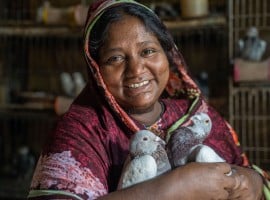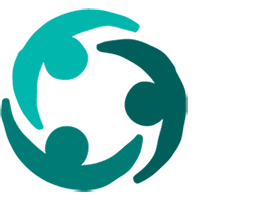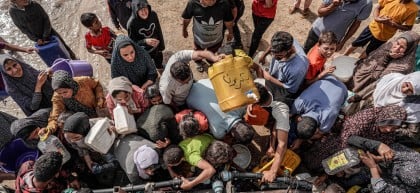
Read our 2024 annual report

Knowledge Hub
Conflict and hunger in Somalia

For the second year in a row, Somalia has ranked as the country with the highest levels of hunger in the world according to the 2025 Global Hunger Index.
A big contributor to this is more than a decade of drought in the country, with other environmental issues (including once-in-a-lifetime floods from the last two years) adding to year after year of failed harvests.
However, climate is only one factor at play in Somalia’s hunger crisis. Another main contributor lies in decades of political instability and insecurity — and the violence in its wake.
Not just the drought
“You know, the reason that I left Burhakaba was not just the drought,” says Naima*, a 22-year-old mother of two. “There was also a clan conflict.”
Naima moved to Burhakaba, a town in Somalia’s Bay region from her home in Mogadishu after marrying. “Life was good,” she says of those early years. “We farmed maize and had enough food to feed our family. Then the drought came.”
Pregnant with her second child and mother to a two-year-old daughter, Naima returned to Mogadishu to be with her mother and grandmother (her husband remained at home). However, she notes that the drought wasn’t the only factor that led to her decision to leave. On the journey, the car Naima was traveling in with her daughter was attacked and robbed by one of the armed groups.

“They had knives and guns and they collected everything we had,” Naima recalls. “It was very scary…I thought that this would be the last day of my life.” She and her child survived, but they struggled to get enough food on the rest of their journey. What she was able to get from those in the vehicle with her went to young Jamilah*.
By the time Naima got to Mogadishu, she was weak and exhausted; her mother immediately brought her to the Concern-supported Wadajir Health Centre Hospital. When she gave birth to her second daughter, she was severely underweight.
One crisis fuelling another
Naima’s story is one of many that have come from Somalis desperate to survive and provide a better life for their children amid several overlapping emergencies. The humanitarian crisis in Somalia is cyclical, fuelled by these different emergencies (both natural and man-made) interacting with one another.
“When the drought came, people started to struggle in life, and this led to clan conflicts,” says Hoodo*, a 30-year-old mother of five who lived in Qoryoley district in the Lower Shabelle region before relocating to an IDP camp near Mogadishu.
“When the two clans fight, they block all the roads in the village to prevent us from leaving. This led to our life becoming very expensive as the price of food went up, and it became difficult to fetch water.”

Even more tragically, Hoodo’s husband was killed in the violence while working on the family’s farm. She felt the loss immediately, both emotionally and practically. “No one was left to provide for us,” she says. She had to pull her oldest son out of school, and she was pregnant with her fifth child.
With help from her family, she was able to negotiate a ride to Mogadishu — thanks to a driver who sympathised with her situation and gave her a discount on the fee (roughly €20), which she couldn’t afford.
The family had a way out, but nothing to eat for the two-day journey.
The cycle of conflict and hunger
These events are part of a cycle of history for Somalia. Sources differ on the official starting point for this protracted crisis. Some say it’s been going on for decades. However, one critical year was 1991, when the central government collapsed under pressure from armed and political factions vying for control. The resulting power vacuum and instability persisted until a federal government was established in 2012. That same year, a severe drought gripped the Horn of Africa. With no government support for affected families, hunger became a weapon of war, as rival groups even resorted to burning crops and farms.
Displacement also increased, with many Somalis fleeing conflict zones to safer areas, arriving at internal displacement camps that were overwhelmed with demand for tents, water, and food.


Those are circumstances that many displaced Somalis still experience in 2025. When Hoodo arrived at a camp in Afgoye, an area near Mogadishu that includes several internal displacement sites, she was able to build a temporary shelter and feed her children with the help of some neighbouring tents who had extra material and supplies to share. The next day, she found work doing laundry. However, “we are still sleeping on the ground,” she says of their situation. For a while, her newborn child Mulki* was sick and suffering malnutrition — which was treated by healthcare workers from Concern and YouthLink.
Against the backdrop of droughts increasing in frequency and severity, the cycle of conflict and hunger continues to drive displacement figures. In the last 15 years, Somalia has seen three droughts, each described as the “worst in decades,” with each subsequent drought becoming more intense. “One after the other, they’re all enough to intensify conflicts over resources and power within the country,” explains Concern Somalia Country Director Richard Nunn.
The impact of another conflict 8,300 km away
The hunger crisis in Somalia has been further impacted by a conflict happening on a completely different continent. Somalia normally sources between 90% and 95% of its grain from Ukraine and Russia. However, following the escalation of conflict in eastern Ukraine in February 2022, trade routes were halted, cutting off supplies from reaching the Horn of Africa (among many other areas around the world).
This caused an increased demand for the grain and other food imports that were available in Somalia. At the end of 2021, a 50kg bag of sorghum cost the equivalent of $8. One year later, it cost $50, meaning although there may be food at the market, the ability of people in those areas to buy or get access to that food is very limited.



Humanitarians in Somalia are struggling to access the people most affected by conflict and hunger
It’s also hard to move food and other supplies around the country, as different armed groups control checkpoints and access to different regions. Often this means that those who need supplies and services the most are unable to access them.
This was what 55-year-old Samiro* faced while moving from their village in Galgudud to Mogadishu. Attacks on their home from armed groups forced Samiro and her seven children to flee, making a 10-day journey to Runirgod (roughly 100 km away) on foot.
“In Runirgod, an armed group controlled the district. We didn’t have food,” Samiro recalls. It took another three weeks for her family to reach Mogadishu. Once they arrived, her infant twin granddaughters were diagnosed with malnutrition and treated at the Concern-supported Banadir Hospital. But it shouldn’t take a month of journeying on foot and another month spent in and out of a health clinic to keep civilians healthy and safe during conflict.
“As long as there is absence of efforts to contain and to deescalate those tensions and conflicts, we will be having challenges in terms of having access,” adds Nunn.

An added challenge
In 2025, Somalia faces an additional challenge to rising hunger rates. Crisis fatigue has led to underfunding and cuts to existing programmes in the country, leaving humanitarians with even fewer resources to meet even the bare minimum of need. As of November 2025, the Humanitarian Response Plan (HRP) for Somalia is only 19.2% funded out of it's total commitments.
Earlier this month, the World Food Programme reported that funding cuts mean that assistance may go from reaching 1.1 million people in Somalia to just 350,000 — meaning that essential food aid will reach less than 10% of those who require it.
“The current level of response is far below what is required to meet the growing needs,” said one representative from the WFP. “Without urgent funding, families already pushed to the edge will be left with nothing at a time when they need it most.”
Meanwhile, between now and the end of the year, the Integrated Food Security Phase Classification (IPC) estimates that hunger rates in Somalia will increase by as much as 27% compared to this summer. This will leave an additional 928,000 people facing high levels of food insecurity (IPC Phase 3 or higher), reaching nearly 4.4 million people affected in total. This includes an estimated 921,000 people who are facing severe hunger. Meaning many families won’t have enough food, leading to serious malnutrition and even increased risk of death. To survive, they may be forced to sell their belongings, leaving them with no other options.

Conflict and hunger in Somalia: Concern’s response
Concern has been in Somalia since 1986. Addressing the causes of hunger in the country continues to be central to our work in the country, with both emergency interventions and longer-term projects designed to build the resilience of affected communities (especially those who are in protracted displacement). We are proud to be UNICEF’s main nutrition partner in the Wadajir district.
A key pillar of our response is unconditional cash transfers (delivered electronically via mobile phones). These enable families to quickly receive money to buy what they most need from local markets, including food and other essentials. Between January 2022 and the end of March 2024, Concern Worldwide distributed €23 million (provided by the European Union) to families, which in turn saved the lives of over 617,000 people.
At the end of 2024, one fifth of Somalia’s population was coping with high levels of food insecurity — including 1.7 million children facing acute malnutrition (roughly a quarter of whom were facing severe acute malnutrition). Working with both local partners in Wadajir as well as the Ministry of Health, we delivered specialised nutrition services through 17 static and mobile facilities, treating over 63,000 children. We also worked with over 160,000 caregivers to give them the support they needed in ensuring the continued health and success of their families.





